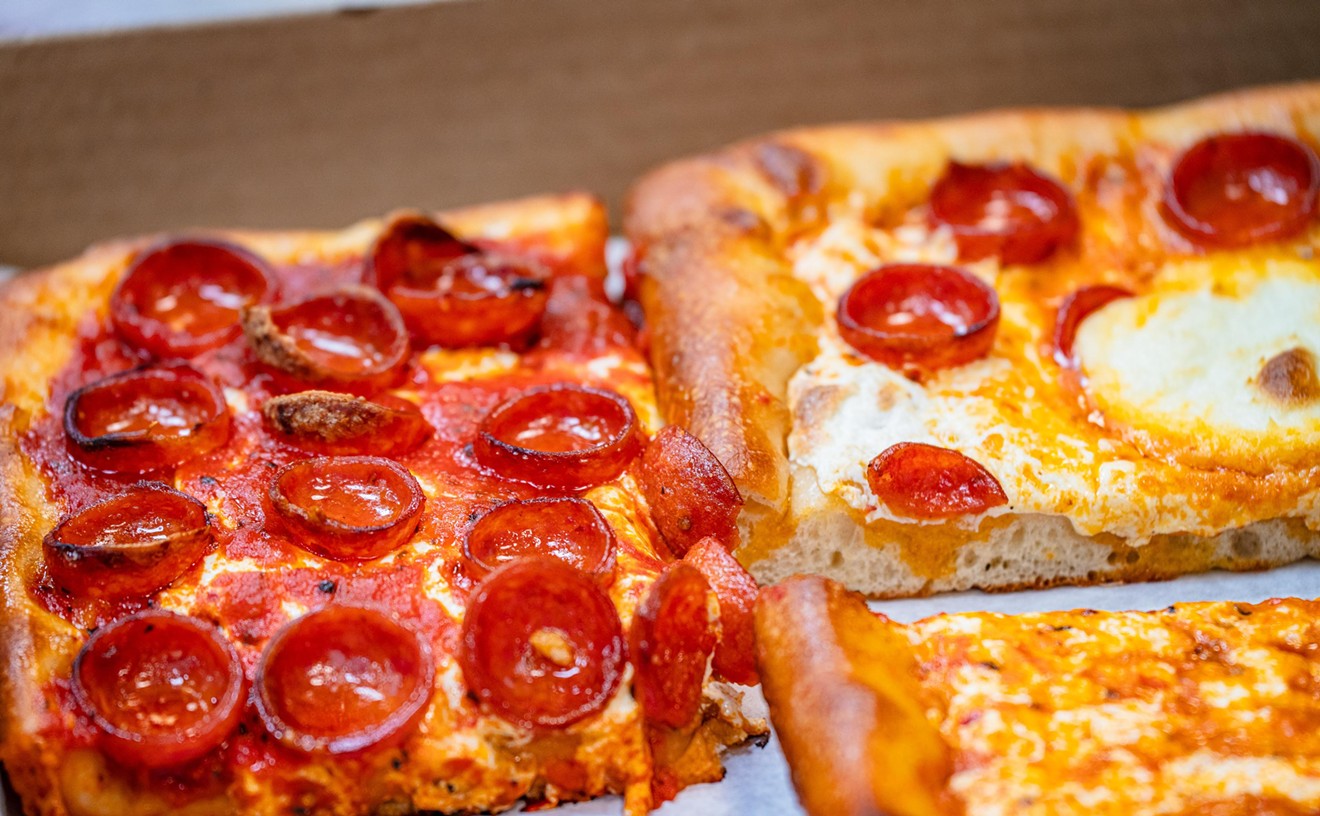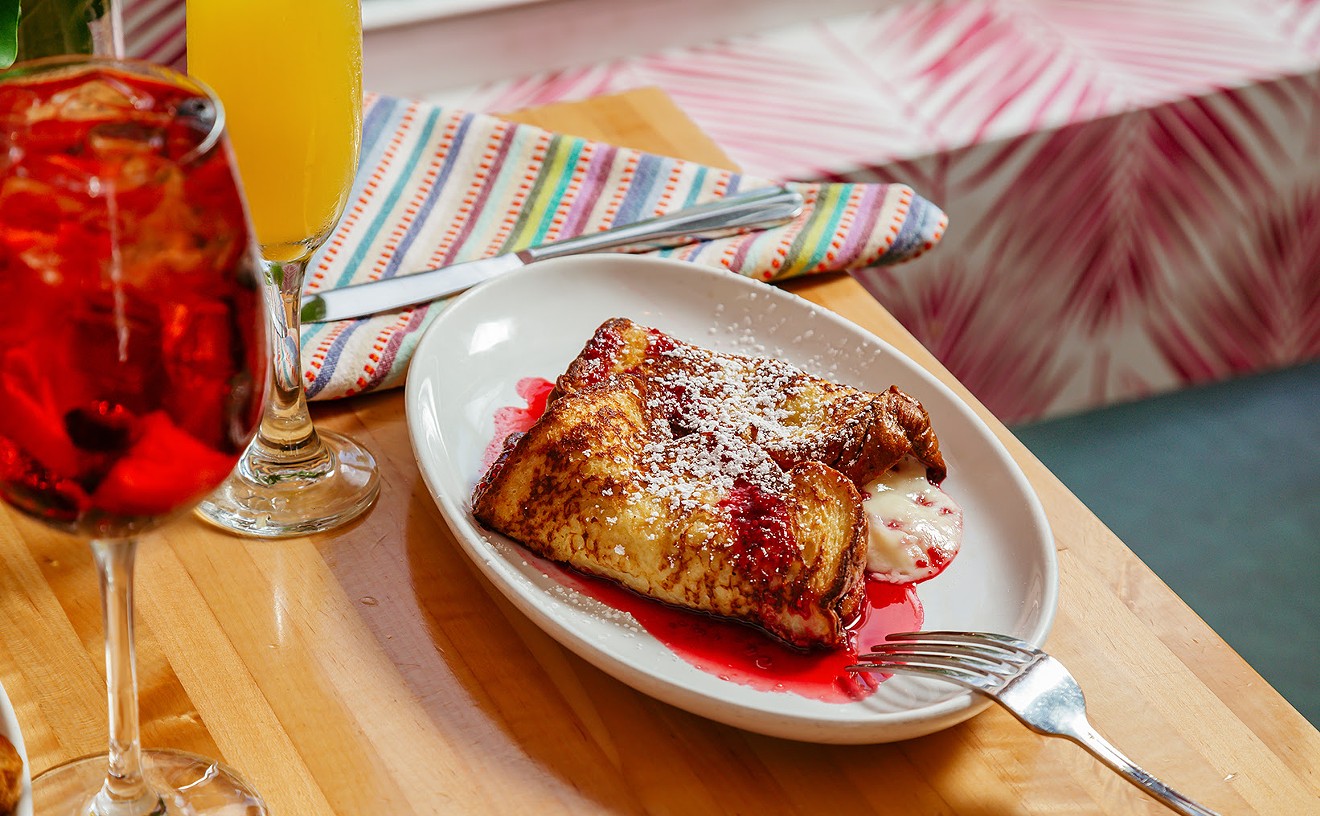Not that such fish freebies were typical, but competition was fierce enough that gimmicks were common -- outrageous makis, nightclub hours, drink specials, and so on. Traditionally famed as low-fat and high-protein, Japanese raw-fish cuisine has always been the stuff of trench warfare in sleek, stylish South Beach.
But sushi wars in Sunny Isles Beach? A place until recently better known for its "55-plus" apartment complexes? A place where gourmet dining meant a potato-pancake pig-out at the Rascal House? Please.
However, anyone who's driven up Collins Avenue in the past couple of years knows that the town has been transformed by a forest of towering oceanfront condos that are definitely not being snapped up by senior citizens on Social Security. So maybe it wasn't so surprising that early this year two competing restaurants began advertising in local papers, suggesting that South Beach was about to get a run for its money. Within walking distance of each other on Collins (as if anyone walked in Sunny Isles) were two sushi bars that seemed determined to outdo each other.
Sumo's ads offered an escalating array of lures: fifteen percent off the check, 2-4-1 maki nights, a Wednesday ladies' night with free sake, weekday happy hours featuring $1.25 sushi, and a "selection of 20 fresh fish." Additionally there was the standard pitch for those reluctant to tackle raw fish: a tacked-on Thai menu. For me, though, the clincher was the advertising line that read, "Fresh uni and toro." Toro, swoon-inducingly buttery belly tuna, is on most Japanese menus, but is seldom actually available. Seeing it touted was beyond thrilling.
Taiko's initial advertisement offered an introductory 30 percent for its January grand opening. Then they rolled out the really big guns: an ad trumpeting, "Enjoy REAL sushi prepared by Japanese chef Kimura." There is not room here to discuss Japan's culinary pride; it'd take up the whole review. But in short, sushi made by a Japanese chef is the cultural equivalent of a Cuban café con leche. You'd think, hey, espresso is espresso, and a cow's a cow. But no. It was better in Cuba, at least before politics there soured the milk. There's no real reason why sushi made by a Japanese chef is considered the ultimate, but clearly this was war.
A taste test revealed no clear victor. There were, however, considerable differences.
At Sumo, where I went with two other women on ladies' night, the free sake wasn't the artisan sort served at Doraku and an increasing number of sushi/sake bars. But it came either hot or cold, arrived in a large carafe that was replenished without undue embarrassing multiple requests, and it wasn't rotgut. What more could a lady want?
Well, for one thing the toro, as advertised. But as usual there wasn't any. "There almost never is," our server admitted. Twenty fresh fish was also inaccurate; the blackboard's catch-of-the-day list numbered five. But the two unusual local fish, triple tail and wahoo, which we tried in purist sashimi form, were excellent. And the grouper -- black grouper, which many aficionados consider the tastiest variety -- was impeccably fresh.
Moving on to makis, Sumo's specials would please novelty lovers more than traditionalists. Most makis featured major cream cheese -- or worse. Dutch gouda seemed an especially bad idea. There was some mislabeling, too. All the rolls we tried that were listed as containing kani (crab), for instance, contained kanikama (crab stick), which is mostly pollack, the generic food fish with no relation to crab whatsoever. This marred an otherwise tasty "crispy Collins," a riceless though battered maki with salmon and asparagus plus the faux crab.
Crab stick also figured in the "tuna lover," which additionally contained avocado, cucumber, red tuna, and so-called white tuna, which tasted nothing like albacore, the only true white tuna. Judging by the fatty texture, this "tuna" was escolar, also known as snake mackerel. The roll was buried in "tempura flakes," nubbins of deep-fried tempura batter, as was another rice-free maki, the elaborate "ultimate" (asparagus, masago, cuke, eel, and shrimp tempura, the whole topped with seared tuna). A sprinkling of tempura flakes adds just a touch of sin, but too much of it transforms a heart-healthy dish into a fast-food experience.
The "cold hot fish," however, was creativity that worked: salmon (or tuna) dressed with a spicy sauce (think Korean kim chee) plus sea salt, pepper, a little sesame oil, and a lot of cilantro. And lightly battered shrimp and vegetable tempura came with a dipping sauce that was unusually and appealingly assertive, thanks to an infusion of tangy lemon juice.
At Taiko the best seats in the house are at the sushi bar, where you can watch the polished work of chef Kimura, who indeed grew up and trained in Japan. He then worked for years in New York at the venerable Saito, a favorite eatery of Japanese businessmen from way back in the Sixties. Though the chef has been in Miami for years now (at Toni's Sushi in South Beach), his nigiri made it clear he has kept up with Manhattan Japanese restaurant styles: Kimura makes big sushi. About twice as much fish overlapped each rice ball on both ends as was on top.
Trends aside, some people find these bigger-than-bite-size pieces awkward. And they are, when using chopsticks. Fortunately, according to Japanese etiquette, it's just fine to eat sushi with fingers, which also enables diners to flip the pieces over so it's the fish slice that gets dunked in soy sauce, not the rice. That way, the rice does not become oversaturated and fall apart. So big slices are really no more unwieldy. In fact since toro was available -- without fanfare -- on both visits, Taiko's supersizing made a gift of the $6.80 price.
Two other large nigiri, hamachi ($3) and hirame ($2.50), were also good, though the former was a bit lacking in taste and soft in texture for fresh Pacific yellowtail. The latter was fluke, summer (or "left-handed") flounder rather than true Japanese hirame.
While rolled sushi at most places is stingy on fish, Taiko's makis contained as generous a proportion of fish to rice as its nigiri. Simple eight-piece salmon and tekka (tuna) makis, $4.25 and $4.75 respectively, were a relatively high-protein bargain. Also a bargain, and hard to find in Miami, was an oshinko roll, rice rolled around pickled daikon. Apparently pleased that an American could enjoy the authentic, salty-brined radish, "like real Japanese," Kimura offered some shreds of spicy shiso leaf to eat with the maki. It was a terrific add.
With the exception of a "volcano roll," which resembled Mt. Fuji, makis were less overwrought than Sumo's. The "Christian and Tara," a spicy tuna roll draped with huge slices of raw salmon, was particularly good. Serious heat seekers, however, would have found the mayo-based sauce much too mild.
A salmon skin roll was flat-out the best I've had in Miami. The skin was plentiful and unusually crisp. Eel sauce was subtly savory and sweet, not gloppy. And along with the crunchy skin, cucumber, and scallion there was also kaiware. Why more sushi bars don't use this refreshingly crunchy, naturally spicy daikon sprout in makis I can't imagine.
Salmon carpaccio was as delightful as that from Toni's Sushi -- because it's identical. What made this plate of thin-sliced raw salmon wonderful was two sauces: a ginger potion underneath for pep, and drizzles of a mayo-based concoction for comfort.
All in all, Taiko is where I'd return. But that's just personal preference. And as I was writing this review, Sumo's latest ad proclaimed, "Now serving Chinese food!" Sharpen those chopsticks. The war continues.









